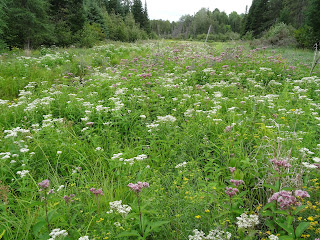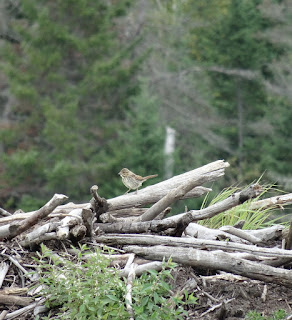Here are a few photos from the trip.
Fireweed (Chamerion angustifolium) is a common sight along roadsides on the Shield. This species frequently pops up following forest fires and can sprout from the ashes and bloom in profusion just several months after a fire event.
There were plenty of marshes to explore. After clambering among deadfall and squinting my way through dense, pokey Black Spruce understorey, these provided a welcome refuge, proved to be biodiversity hotspots, and were sought out as the preferred lunch destinations.
Steeplebush (Spiraea tomentosa), otherwise known as Hardhack. In comparison with Narrow-leaved Meadowsweet (S. alba) the leaves are tough like leather, hairy and the flowers can range from light to deep pink rather than white.
The lagg (the term for the watery 'moat' surrounding a floating peat mat) stopped me this time. Given the choice of confirming the species of Cottongrass way out there at the risk of becoming a bog body and settling for "Eriophorum sp.", I took the latter option in this case.
My favourite upland find for the week was a few clumps of seen-better-days Rusty Woodsia (Woodsia ilvensis) growing on a rock barren among an open canopy of stunted Red Oak and alongside Tufted Hairgrass and Poverty Oat Grass, an (although locally fairly widespread) habitat.
These openings made for some nice vistas.
Fragrant White Pond Lily (Nymphaea odorata).
Common along roadsides and hydrocuts, the pale blooms of Pearly Everlasting (Anaphalis margaritacea) are persistent long after they have been picked or a frost. From what I can gather, both the genus and species epithet translate to 'of pearls', kind of like 'pearl of pearls'.
Rugged Goldenrod (Solidago squarrosa) is best identified by the recurved phyllaries (the small bracts or scales) below the petals. Interestingly, this goldenrod has a bit of an eastern seaboard distribution, check it out.
Beaver dams giveth wetland and beaver dams taketh away wetland (or at least created a massive drawdown effect on this peatland when the levee broke.
Larger Canada St. John's Wort (Hypericum majus) seems to well on desiccated organics, there were acres of it.
A weedy species that turned the table on Eurasian weeds and has become well-established in Europe, a different Fireweed (Erechtites hieraciifolius).
Nodding Beggar-ticks (Bidens cernua). For what seemed like a desert when I approached, this drawdown area, the anti-beaver meadow had a decent assemblage of wetland herbs.
Round-leaved Sundew (Drosera intermedia). If you get down poking around in the Sphagnum you can sometimes find hundreds of these per square meter.
White Beaked-rush (Rhyncospora alba).
Finally got a good look at one, Virginia Cottongrass (Eriophorum virginicum). Standing among a few thousand of these swaying in the wind I declared a suitable lunch break spot...
...on top of an abandoned beaver lodge which had a new tennant.
A stand of Wire Sedge (Carex lasiocarpa), a species which dominated a number of fen mats and made for much easier walking than the mine-field that is a Tussock Sedge (C. stricta) marsh.
4 Snapping Turtles on the week, some of which were still snapping.
Rattlensake Manna Grass (Glyceria canadensis)
Perfect timing for Bog Goldenrod (Solidago uliginosa).
Orange-belted or Tri-coloured Bumblebee (Bombus ternarius). These might have been the most abundant bee for the week and made for some slow wading through forb-dominant marshes like the one in the photo below. The buzz of the bees almost drowned out the sound of Billy Bob's 12-gauge in a nearby gravel pit!
I had never seen Houghton's Cyperus (Cyperus houghtonii) before, but that's what I keyed this out to be, S3 to boot! It was growing at the bottom of a sandy borrow pit plenty disturbed by the rippin' and tearin' of ATVs.
Purple-stemmed Aster (Symphyotrichum puniceum).
Bird sightings included stumbling upon an Osprey with a half-eaten duck, Common Loons during evening paddles and a Ruby-throated Hummingbird playing chicken with my face.
Swamp Sparrow accompanied us in the marsh clearings.
This Eastern Phoebe taunted me with it's quick flights back and forth over the wetland lagg that I could not cross "Look what I can do!"
A curious Song Sparrow
And a shot of a female Wood Duck just before disappearing through a breach in a beaver dam.





































An interesting post, Patrick....definitely a more northern flavour than what I am used to.
ReplyDeleteThanks Allen, I should have a 'part II' in the coming weeks. I quite liked your post on floodplain flora, it made me think of a few of my favourite spots on the Thames and Grand.
ReplyDelete